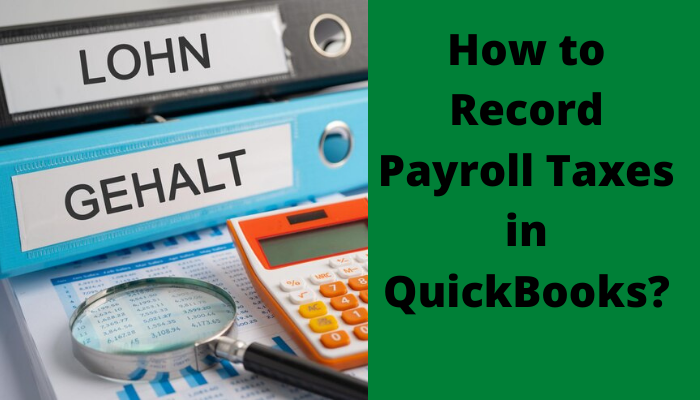
How to Record Payroll Taxes in QuickBooks?
QuickBooks Payroll is part of QuickBooks which is used to manage an organisations processes like onboarding, compensation calculation, attendance tracking, and benefits administration. It includes calculating employee earnings and deducting federal and state payroll taxes. Payroll helps Human resources and employees to manage their services for small businesses. QuickBooks Payroll provides users to fulfill their business requirements, it allows users to manage and control their company’s payroll. QuickBooks Payroll can be complicated and can be time-saving.
QuickBooks is market-driving monetary Accounting programming. It is full-fledged accounting software that is used for accounting purposes. QuickBooks help users to run their business more easily. QuickBooks provides integrated tools like monitoring financial reports, tracking expenses, bank records, dragging invoices, etc.
Payroll Accounting is a type of process which includes the recording of payments of a company’s employees. Payroll accounting typically includes wages, bonuses, salary, commissions, employees overtime, etc. The calculation of the payroll is strongly influenced by the legal system of the country.
In this article, we discussed how to record payroll taxes in QuickBooks in-depth and in detail. After reading this article you should be able to record payroll taxes in QuickBooks. Read this article carefully.
Table of Contents
How does payroll work?
- Complete and up to date paperwork of all employees.
- Set-up Your payroll schedule.
- Calculate the gross salary of your employees.(Salaried, Hourly Workers, and Overtime).
- Deduction from health care plan, social security, Taxes, etc.
- Pay your Employees.
- Keep Record of payments.
Steps to Record Payroll Taxes in QuickBooks:
If you want to ecord Payroll Taxes in QuickBooks then follow bellow discussed procedure, with this procedure you can easily record payroll taxes in Quickbooks. If due to any reason if you don’ want to read read follow the procedure, then contact a Quickbooks ProAdvisor.
1. Record Payroll Tax for: (Prior Tax Period)
- Setup and Open QuickBooks.
- Go to New and select Tax.
- Select Payroll Tax.
- Select and Enter Prior Tax History.
- Click on Add Payment.
- Fill Requirements (payments information, etc.)
- Hit on Ok!
2. Record Payroll Tax for: (Current Due)
- Setup and Open QuickBooks.
- Go to New and Select Tax.
- Select Payroll Tax.
- Click On Pay Taxes.
- Select Record payment. (From Pay Takes)
- For Payment Dates:
- Click on Other.
- Enter Date. (Payment Date)
- Fill Cheque Number.
- Click On Approve.
- And Print!
3. Verify Your Recorded Payroll Taxes:
→ Go to New and Select Payroll Report.
→ Click on Manage Payroll.
→ Select Payroll Taxes Payments Report.
→ Confirm Your Payroll Taxes Recorded.
4. Frequently Ask Questions:
- Does QuickBooks automatically Calculate Payroll taxes?
Yes, QuickBooks Payroll provides this feature in QuickBooks. Payroll and taxes calculations in QuickBooks derive from payroll data and transactions as your entry. You can use a Detail Review Report.
- What are the features of Payroll related to payroll taxes?
- QuickBooks Payroll fills the payroll tax forms for you.
- QuickBooks Payroll automatically calculates federal and state payroll taxes.
- You can E-pay payroll taxes directly from QuickBooks.
- You can Pay your employees with a check or direct deposit.

